Excerpt from the twelfth chapter "The Problem in South America and the West Indies" of Sir Henry Haworth's "The Mammoth and the Flood" book (pp. 345-354):We may apply the same reasoning to other normal causes of extinction. Murrain and pestilence would hardly overwhelm the greater part of the fauna of a continent, or rather, to speak plainly, of both hemispheres, and be equally potent in its destructive tendency with men and mice, with mastodons and marmosets. Nor would any causes we know to be operating now account for the caches or heaps of incongruous beasts found in precisely the same fresh condition, and yet piled together in confused masses.
This mixture of animals of different habits and habitats, — of carnivores and pachyderms and herbivores — is most puzzling, especially when the remains show so often a common freshness and an unworn and ungnawed appearance. Death certainly has no favourites, and is singularly neutral in its methods; but it does not, in its normal moods at all events, collect great mylodons and thickly-hided megatheres, nimble opossums and safely-cuirassed glyptodons, cavies and mastodons, and kill them together and bury them together.
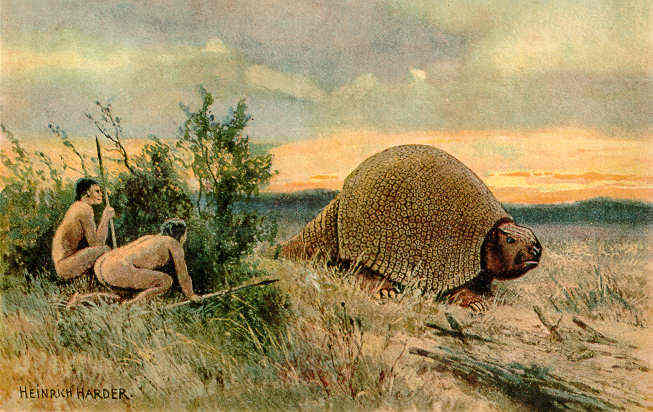 Paleoindian hunt for the glyptodon in the artist's view
Paleoindian hunt for the glyptodon in the artist's viewAgain, as in the Old World, the animals are found of all ages. Thus, in a cavern explored by Lund in 1844, he found remains of two species of Scelidotheria of very dissimilar ages, down even to embryos.
(Liais, 383) He found similar series, from young to old animals, of the genus Coelodon. This discovery of young animals virtually intact, with their bones ungnawed, in a country more than usually abounding in carnivora, is singularly eloquent.
Putting aside these causes, let us turn to more normal ones. “Did man,” says Darwin again, “destroy, as has been suggested, the unwieldy megatherium and tho other edentata? We must at least look to some other cause for the extinction of the little tucutuco and of the numerous fossil mice and other small quadrupeds.” Again, man would hardly have taken pains to kill these great beasts, requiring unusual efforts in savages, and do so out of mere wantonness. He would not have left the carcases intact, and buried them in deep mud or gravel. Nor is there any evidence of any kind that man destroyed them, so far as I know.
The carnivorous animals are as little likely to have left the carcases uneaten and the bones ungnawed, and we must remember that South America was then tenanted by carnivores with peculiarly trenchant teeth, such as the smilodon. Besides, the skeletons and remains of these same carnivores are themselves found singularly fresh and well preserved, and in a condition showing they closed their careers when in full health and strength. Whatever the cause of death, it overwhelmed them just as much as the helpless lamas; the well-protected glyptodons and armadilloes, with the same neutral consistency as the unprotected monkeys and cavies.
If the animals died sporadically and at different times, how is it their remains are invariably so fresh and so intact? This is certainly not according to any process to which uniformitarians can appeal now. Again, if their remains were buried by sporadic causes, how is it they lie in unbroken beds of loam spreading over immense areas. We cannot dig a grave to hold a child even, without disturbing the continuity of the beds. How could megatheriums and mylodons be thus buried?
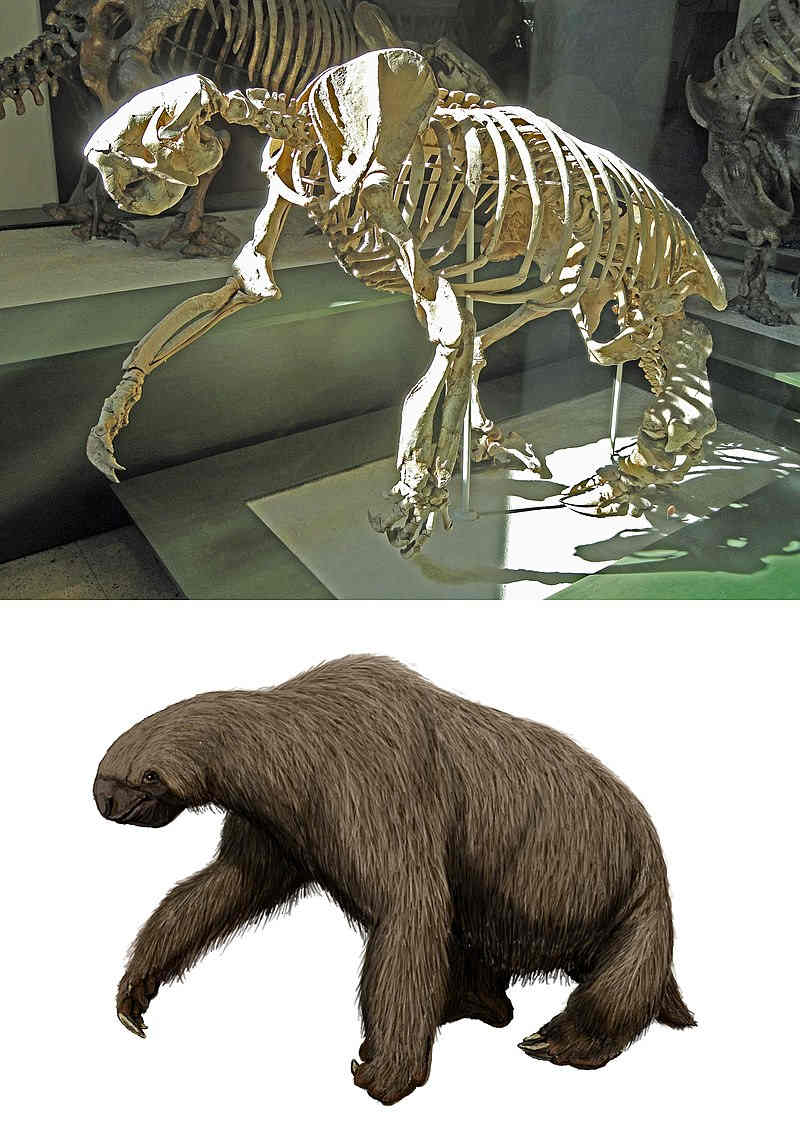 Skeleton of Megalonyx wheatleyi combined with restoration
Skeleton of Megalonyx wheatleyi combined with restorationThat the cause of their death was violent and sudden seems to follow, not only from the various arguments I have adduced in the case of Europe and Asia, but from other and special circumstances. Thus Burmeister mentions the discovery of a skeleton of a female
mylodon gracilis alongside of that of its young one, surely a most remarkable fact, and which draws from him, although an opponent of the theory for which I am fighting, the remark:
“Des découvertes semblables ne sont pas rares et prouvent que les deux animaux out été tués à l’improviste, au lieu même de leur repas.” This conclusion also follows, as he urges, from the finding of entire skeletons in their natural position standing upright; while the discovery of defective skeletons turned upside down, prove that the animals were in other cases killed before they were swept away and buried in tho mud, especially when the head, tail, and extremities are missing, these being the portions of the trunk most easily separated.
(Rep. Arg. ii. 190) Such facts as these are worth a library of speculation. They are quite inconsistent with the normal operations of Nature.
Burmeister again has remarked that the skeletons of megatheria have lost their left extremities more frequently than their right ones, which follows from their nearly always being found lying on their right sides. This, he infers, was caused by the fact of the right sides of the animals having been heavier than the left ones, causing them to fall on that side.
(Id. 191) This again is a result which would hardly follow from any cause that is normal, and points to some cause which dealt with these carcases in a violent way, and deposited them according to the laws of gravity.
Sometimes the limbs are found some distance from the trunk, and sometimes the bones are found scattered over a small space,
(Id. 191) again showing that in such cases the force which disintegrated them was transitory and sudden. If it had been continuous, the bones would have been scattered beyond recall. This violent and sudden cause seems to me to also explain the facts referred to by Burmeister when he says the cuirasses of the great glyptodons are generally reversed. Such animals do not turn on their backs to die, and they were evidently turned over by a violent cause. The various conditions of the problem necessitate our coming to one conclusion only, and this has been arrived at as much by uniformitarians as by their opponents, namely, an appeal to water as a partial if not a complete explanation of the phenomena.
If the megatheria and glyptodons could easily resist the puny weapons of unclad savages and survive a struggle with the carnivora, they were as helpless as the monkeys and the lamas when assailed by flooding water. Water was quite competent to destroy them, and to do so without disintegrating their bodies or injuring their bones. Water again is the only agency known to me which could carry sloths and other animals whose natural habitat is certainly not in caverns, and bury them in cave earth as they have been found in the Brazilian caves. Water, again, can alone explain the finding of the carapaces of the great armadilloes standing upright on their edges in the Pampas mud. Burmeister refers to this, and says he himself had seen an example of this in the Valley of La Pumilla, and says of it, “Der Panzer stand senkrecht in Lehm, die offene Bauchseite gegen den Wasseritz gewendet, den gewölbtуn Rücken gegen die Erde.”
(See Burmeister,, Reise, ii. 85) And in these cases they are found empty, and not with the skeletons inside them as they are found when in their natural position. This proves to my mind that the skeleton was already disintegrated when the water took it up, and makes it still more certain that the cause of transport and deposition was sudden and violent. It is only water that could take up these great cuirasses and leave them, as the stone axes have been found at Abbeville standing perpendicularly in the lehm.
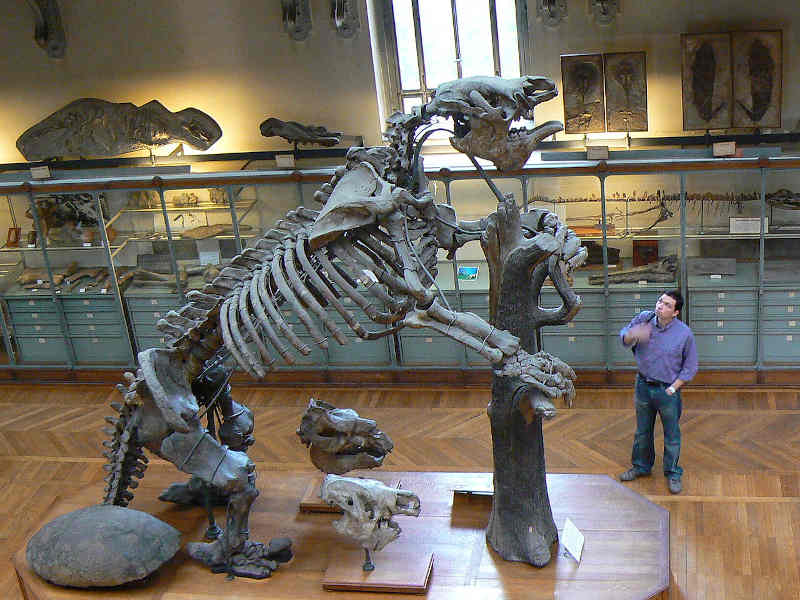 Skeleton of Megatherium americanum
Skeleton of Megatherium americanumM. Liais points out that the Brazilian caverns, before they were filled with their contents, were for a while unoccupied, and that a coating of stalagmite covers their sides and bottoms. On this lie the bones in a heterogeneous mass, many of them in deep recesses, as in Europe — “Il est, au reste, digne de remarque, que les trous profonda sont le plus souvent très riches en ossements fossiles d’espèces éteintes”
(Liais, 167) — and so arranged that, like Lund and other explorers, he is obliged to postulate currents of water as the prime cause of their distribution.
Lastly, water is the only cause known to me which could bury the carcases in their fresh condition under many feet of continuous loam over many hundreds of miles of country, covering them with a protecting mantle against the weather, and do so not only in the open country, but in the interior of the caves. We are told, that in Brazil, no less than in Europe, is similar in texture to that covering the adjacent country, and was evidently deposited by the same wide-spread and general cause.
The normal way of accounting for the water which is necessitated by this postulate is to appeal to the current operations of nature, as presented by river and other intermittent floods; but this, as in Europe and in North America, is an altogether inadequate cause, Darwin said long ago, “The number of bones embedded in the grand estuary deposit of the Pampas must be very great. I myself heard of and saw many groups. The names of such places, as ‘the Stream of the Animal,’ ‘the Hill of the Giant,’ tell the same story. At other times I heard of the marvellous property of certain rivers which had the power of changing small bones into large, or, as some maintained, the bones themselves grew.
As far as I am aware, not one of these animals, as was formerly supposed, perished in the marshes or muddy rivers of the present land, but their bones have been exposed by the stream intersecting the deposit in which their remains were formerly buried. We may therefore conclude that the whole area of the Pampas is one wide sepulchre for these extinct animals.” (Voyage of the Beagle, iii. 155)Again, let us listen to another great authority on South America, D’Orbigny. “I ought to add,” he says, “that the effects of rivers as transporting agencies have been greatly exaggerated in arguments about the distribution of the great mammals. Such an idea applies really only to our European rivers, whose banks are covered with towns, and where men continually cause animals to be thrown in. In my journeys on the great rivers, such as the Parana, the Paraguay, the Plata, and all the Bolivian affluents of the Amazon, and during eight years, I do not remember having seen a single floating animal in the vast solitudes of America. Animals never voluntarily enter the great rivers, and it is very seldom they are overtaken by inundations.”
(Op. cit. iii. 3, 86 note)Burmeister, while admitting that the destruction of the animals in many cases, and their burial, was due to water, argues that the water was in the form of local and intermittent floods. He argues that if they had been deposited by one general rush of water, we should not find the greater portion of the bones in the lower parts and so few in the upper parts of the Pampas mud. Now it seems to me that nothing could be plainer proof that the remains were deposited by a general inundation. In the first place, the deposit itself is largely homogeneous and unstratified, and if it were the result of a great movement of water, all the heavier objects, notably the very heavy carcases and bones of the great sloths and glyptodons, would be deposited in the lower parts of the beds, while the lighter objects and remains would be found in the upper parts, the sorting being the natural result of the force of gravitation. If the deposition were continuous and gentle, no such sorting would take place. Again, if the bodies and skeletons had been rolled along in rivers or tossed about in river floods, they would have been disintegrated and completely scattered. The finding of so many of the bones of individual animals within a small area shows that whatever broke their continuity was a sudden and transient movement, and not a continuous one.
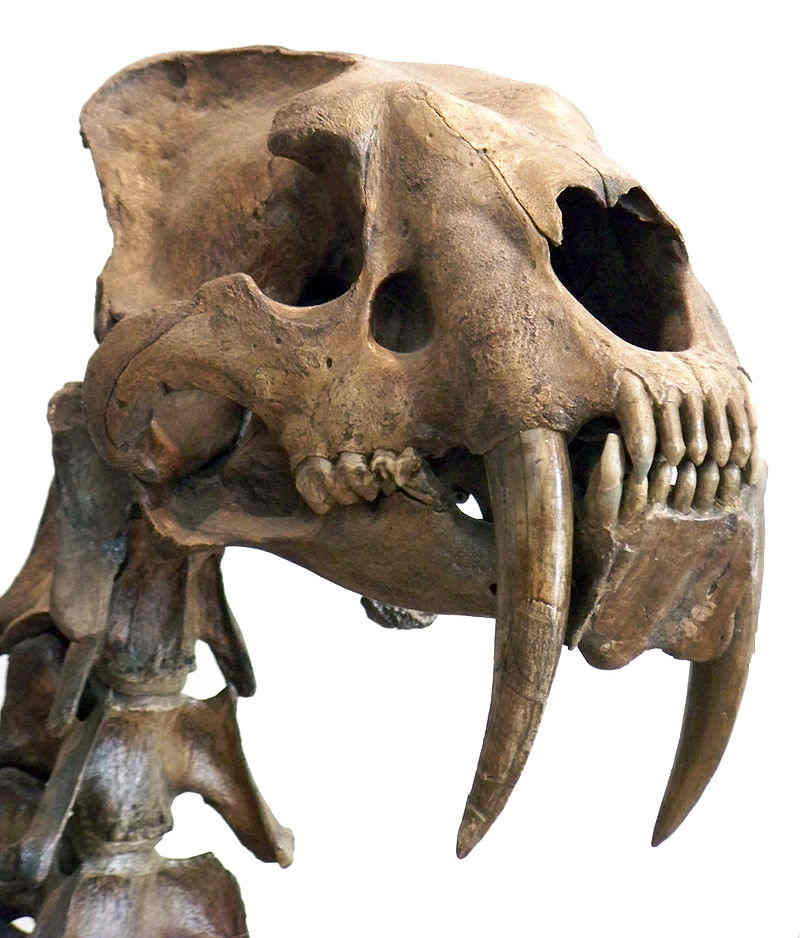 Skull of smilodon
Skull of smilodonBut how are we to invoke local floods of this kind in all parts of South America, where there are rivers and where there are none, in the valleys of the Plata and the Parana, in the caverns of Brazil, on the plateaux of Bolivia, and on the western flanks of the Cordilleras? The continental uniformity of the results is only consistent with a continental cause. This displaces the view so often urged by the patrons of easy methods in science, that the animals of the pleistocene age chiefly perished by being drowned in rivers and were buried by their mud, a view upon which we have already animadverted when urged in regard to Siberia and Europe. Again, a destruction of life so complete, so wide-spread, so independent of climatic and physical considerations, so absolutely at variance with every kind of normal process of extinction that we can think of, is assuredly consistent only with one theory, namely, that which appeals to a catastrophe on a gigantic scale. A huge hecatomb covering two continents with the corpses of a myriad herds can only be imagined as the result of a sudden, complete, and wide-spread catastrophe; and this is even more certain when we remember how cosmopolitan in constitution and habits such animals as the horse, the mastodon, the megatherium, &c., must have been to have lived in the extremely diversified terrestrial provinces where their remains occur.
The difficulty of meeting these necessities of the case by any theory of uniformity has been felt even more by inquirers on South American geology than in Europe or Asia. Darwin long ago said, “It is impossible to reflect on the changed state of the American continent without the deepest astonishment. Formerly it must have swarmed with great monsters; now we find mere pigmies, compared with the antecedent allied races.... The greater number, if not all, of these extinct quadrupeds lived at a period and were the contemporaries of the existing sea-shells. Since they lived no very great change in the form of the land can have taken place. What, then, has exterminated so many species and whole genera? The mind at first is irresistibly hurried into the belief of some great catastrophe; but thus to destroy animals, both large and small, in Southern Patagonia, in Brazil, on the Cordillera of Peru, in North America, and up to Behring Straits, we must shake the entire frame-work of the globe.” The great naturalist then faces the various theories which have been suggested to account for the facts, but discards them in turn, and leaves the problem unsolved, proving how great a stumbling block he, the most ingenious of inquirers, found it.
His distinguished successor, D’Orbigny, appealed, as I appeal, to a cataclysm involving a huge flood of water.
“I was in a position,” says M. d’Orbigny, “to study the effects of inundations on the mammals of the province of Moxos (Bolivia), where these inundations are periodical, and I am certain that there the animals instinctively fly from the fluvial tide and take refuge in places further removed from the water, and on pieces of high ground, where they find themselves momentarily congregated together. Ruminants sometimes die for want of food under such circumstances, and the natives mention certain years when this has occurred, but their bodies remain far from the rivers on small plateaux, or in the depths of the forests.”
(Op. cit. iii. 4, 151)This seems to me to describe very neatly the ordinary results of a great flood. If we enlarge our area from a limited district to a continent, and invoke a correspondingly large cause, we shall at once explain the effects. But to pass on. “It would seem,” he says, “that one cause destroyed the terrestrial animals of South America, and that this cause is to be found in great dislocations of the ground caused by the upheaval of the Cordilleras. If not, it is difficult to conceive on the one hand the sudden and fortuitous destruction of the great animals which inhabited the American continents, and on the other the vast deposit of Pampan mud.”
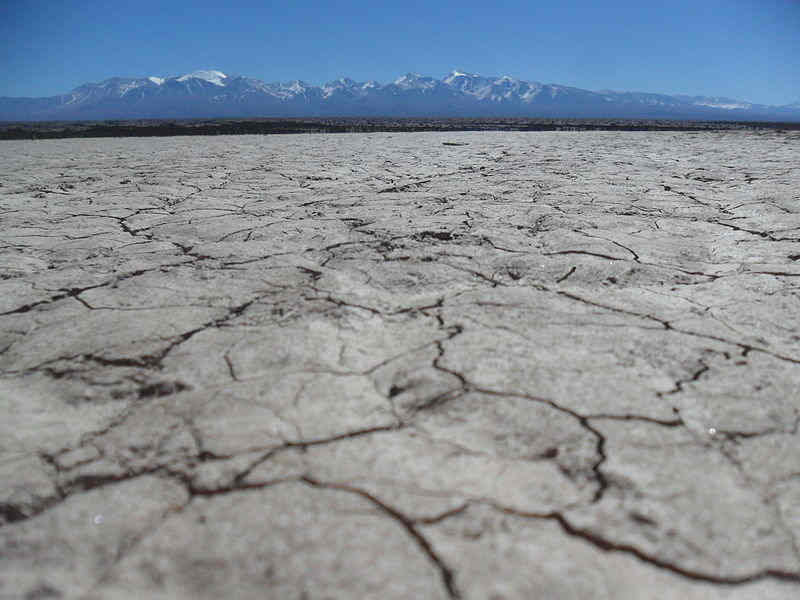 Pampa del Leoncito
Pampa del Leoncito“I argue that this destruction was caused by an invasion of the continent by water, a view which is completely en rapport with the facts presented by the great Pampian deposit, which was clearly laid down by water. How otherwise can we account for this complete destruction and the homogeneousness of the Pampas deposits containing bones? I find an evident proof of this in the immense number of bones and of entire animals whose numbers are greatest at the outlets of the valleys, as Mr. Darwin shows. He found the greatest number of the remains at Bahia Blanca, at Bajada, also on the coast, and on the affluents of the Rio Negro, also at the outlet of the valley. This proves that the animals were floated, and hence were chiefly carried to the coast.”
Again he says, “This hypothesis necessitates that the Pampas mud was deposited suddenly as the result of violent floods of water, which carried off the soil and other superficial débris, and mingled them together. This homogeneousness of the soil in all parts of the Pampas, even in places 200 leagues apart, is very remarkable. These are not different strata differently coloured, but a homogeneous mass, which is more or less porous, and shows no signs of distinct stratification (that is, it is like the European loess). The deposit is also of one uniform colour, as if it had been mixed in one muddy flood slightly tinted by oxide of iron. The bones, again, are only found isolated in the lower strata, while entire animals occur on the circumference or the upper part of the basin. Thus they are very rare at Buenos Ayres, while they abound in the Banda Oriental and in the White Bay. Mr. Darwin says that they are heaped up in the latter place, which again supports this contention. Another argument may be drawn from the fact that the Pampas mud is identical in colour and appearance with the earth in which the fossil remains occur in the caverns and fissures of Minaes Geraes in Brazil, and the fragments brought by M. Clausen are completely like the others in colour and texture.”
Again he says, “After having seen at Callao the ravages which a simple earthquake may make, I am justified in believing that the upheaval of the Andes would suffice to destroy at one stroke by a movement of the water all the terrestrial faunas of the globe. At Callao, during the earthquake which occurred at the end of the last century, the waters carried over the land ships there at anchor, and changed the whole aspect of the country, still covered with pebbles.”
(Op. cit. iii 3, 82)In summing up his results, M. d’Orbigny says that it is to the sudden rise of the Cordilleras he attributes the sudden movement of the sea, which invaded all at once the continent, carried off and overwhelmed the mastodons which inhabited the eastern flanks of the Bolivian Cordillera, the megatheriums, megalonyxes, and the multitude of animals daily being discovered in the caverns and the fissures of the mountains of Brazil — all the species, in fact, which are extinct. It was then perhaps that, mixed with the earth, the animals were tumultuously deposited in the lower parts of the tertiary basin of the Pampas, and thus formed the immense deposit of Pampas mud.
(Op. cit. iii 3, 82)Again he says, “My final conclusion from the geological facts I observed in America is, that there was a perfect coincidence between the upheaval of the Cordilleras, the destruction of the great race of animals, and the great deposit of Pampas mud. Thus these three questions of immense importance for American geology and for the chronological history of faunae may be explained by one cause, namely, the upheaval of the Cordilleras, to which we may perhaps attribute the analogous phenomena of which Europe has been the theatre.”
(Op. cit. iii 3, 85, 86)This language, which will sound harsh to ears tuned to the commonplaces of uniformity, is, I believe, most strictly true, and it will be admitted that if any inquirer of modern times had acquired a light to generalize on such a subject from the long and patient researches he had made, no one has equal claims with D’Orbigny to speak with authority about South American geology.
The theory here urged not only accounts for the facts, but it is the only theory of which I can conceive that does. It explains how the huge unwieldy beasts and the animals living on the level plains were overwhelmed, while the smaller creatures, those with a more nimble gait or those living on places of vantage, escaped, and not only explains the destruction of the animals, but also their burial.
#
america #
book #
catastrophism #
climatechange #
darwin #
deluge #
flood #
geology #
mammoth #
mastodon #
memory #
nature #
pampa #
past #
revision #
science #
weather